|

|
A sheet of water streams off
the rounded tail of a humpback whale (Megaptera
novaeangliae). click image for more...
(photo: Dann Blackwood- USGS)
|
|

|
The right whale (Eubalaena
glacialis) was so named by whalers because it
was the right whale to hunt -- large, slow, with
thick layers click image for more... (photo:
Center for Coastal Studies)
|
|

|
The Atlantic white-sided
dolphin (Lagenorhynchus acutus) is known to
ride the bow waves of boats. click image for
more... (photo: Center for Coastal
Studies)
|
|

|
Many species of birds visit
the sanctuary throughout the year, including summer
visitors like these greater shearwaters
(Puffinus gravis). click image for
more(photo: Dann Blackwood, USGS)
|
|

|
The ocean sunfish (Mola
mola) drifts into the sanctuary during summer
months, looking like a floating pancake. This large
fish feeds primarily on jellyfish and other
gelatinous zooplankton. (photo: Greg Skomal)
|
|

|
A common shark in the
Stellwagen Bank Sanctuary is the blue shark
(Prionace glauca). Sharks are classified as
cartilaginous fish, click image for more...
(photo: Greg Skomal)
|
|

|
Atlantic bluefin tuna
(Thunnus thynnus) cruise through the
sanctuary during their annual migrations up the
eastern seaboard. Young fish travel click image
for more... (photo: Greg Skomal)
|
|

|
A commercially important
groundfish species, the haddock (Melanogrammus
aeglefinus) is click image for more...
(photo: Peter Auster and Paul Donaldson,
National Undersea Research Center, UConn.)
|

|
The fearsome appearance of
the wolf fish (Anarhichas lupus) belies the
fact that it is usually found hiding click image
for more... (photo: Peter Auster and Paul
Donaldson, National Undersea Research Center,
UConn.)
|
|

|
Redfish (Sebastes
fasciatus), also known as ocean perch, are
found both in deep boulder reefs click image for
more... (photo: Peter Auster and Paul
Donaldson, National Undersea Research Center,
UConn.)
|
|

|
This flounder is one of
several flatfish found on the bank and in the
basin. Development of juveniles click image for
more... (photo: Dann Blackwood and Page
Valentine, USGS)
|
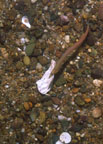
|
The pointy nose of the sand
lance (Ammodytes americanus) allows this
small fish to dive headfirst into the sand to hide.
Humpbacks have developed various feeding techniques
to capture this fish, including corralling schools
click image for more... (photo: Dann
Blackwood and Page Valentine, USGS)
|
|

|
The long-finned squid
(Loligo pealei) swims in large schools
during the day but may dig itself a depression in
the sand at night to rest. click image for
more... (photo: Norman Despres)
|
|
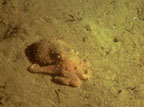
|
The octopus (Octopus
vulgaris) is a shell-less mollusks. It is much
more passive than the squid. click image for
more... (photo: Peter Auster and Paul
Donaldson, National Undersea Research Center,
UConn)
|
|

|
The sea scallop
(Placopecten magellanicus) has over 100 blue
eyes along the edge of its mantle, with which it
senses light intensity. This mollusk click image
for more... (photo: Dann Blackwood,
USGS)
|
|

|
The naked sea butterfly
(Clione limacina) "flies" through the water
by flapping a small pair of wings at the front of
its body. It is classified as a gastropod, and has
a small coiled shell as an embryo. (photo: Jeff
Hannigan)
|
|
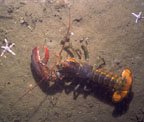
|
The American lobster
(Homarus americanus) finds homes in rock
piles or digs holes in muddy places. Its claws,
used for catching and crushingclick image for
more... (photo: Dann Blackwood and Page
Valentine, USGS)
|
|
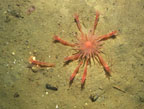
|
Northern pink shrimp
(Pandallid species) form a ring and slip
below an anemone (Bolocera tuidiae), which
appears to be click image for more...
(photo: Dann Blackwood and Page Valentine,
USGS)
|
|
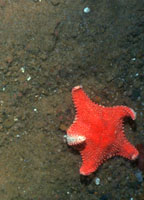
|
This horse star
(Hippasteria phrygiana) appears to have a
personality of its own. Rows of tube feet along the
underside of the star allow it to move along the
surface. (photo: Dann Blackwood and Page Valentine,
USGS)
|
|
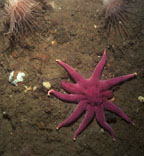
|
Smooth sunstars (Solaster
endeca) usually have 9-10 arms; if lost, an arm
can be regenerated (as is seen here). These stars
come in a variety of colors including reddish,
pink, yellow, violet-red, and purple. (photo: Dann
Blackwood and Page Valentine, USGS)
|
|

|
The North Atlantic sea
cucumber (Cucumaria frondosa) feeds with
mucus-covered tentacles that click image for
more... (photo: Dann Blackwood and Page
Valentine, USGS)
|
|

|
The sea gooseberry
(Pleuobrachia pileus) is a ctenophore -- a
form of gelatinous zooplankton. Unlike jellyfish,
these creatures do click image for more...
(photo: Jeff Hannigan)
|
|

|
The moon jelly (Aurelia
aurita) is a common jellyfish in these waters. It
has four distinct horseshoe-shaped gonads and small
tentacles. click image for more... (photo:
Jeff Hannigan)
|
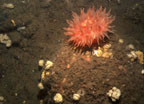
|
A northern red anemone
(Urticina felina) sits atop a rock encrusted
with other living organisms, including brachiopods
and sponges. click image for more... (photo:
Dan Blackwood, USGS - Woods Hole, MA)
|
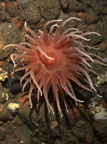
|
The northern cerianthid
(Cerianthus borealis) is related to the
anemone. Unlike its cousins who grasp onto rocks,
the cerianthid buries itself in the sand so that
only its oral disk, tentacles and part of its
column show. (photo: Dann Blackwood and Page
Valentine, USGS)
|
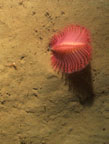
|
A downward-looking camera
photographed this sea pen (Pennatula aculeata)
sitting in the mud. These animals are related
to soft corals. (photo: Dann Blackwood and Page
Valentine, USGS)
|
|

|
This rock in the sanctuary is
an prime example of marine biodiversity. click
image for more... (photo: Peter Auster and
Paul Donaldson, National Undersea Research Center,
UConn)
|
|

|
Diatoms, singly or in chains
as in this case, fill the waters over Stellwagen
Bank. This golden brown algae turns the water a
murky green -- click image for more...
(photo: Paul Hargraves, URI)
|





